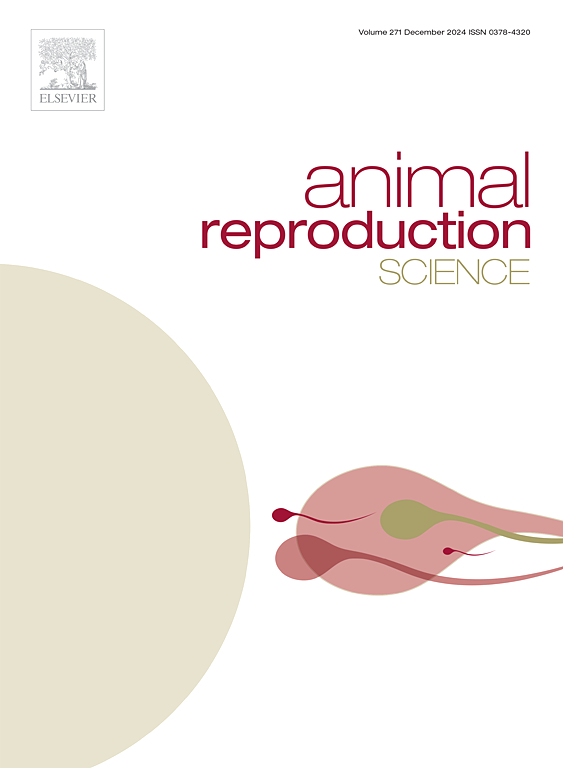精子性别分类对精子质量和牛体外胚胎生产的影响
IF 2.2
2区 农林科学
Q1 AGRICULTURE, DAIRY & ANIMAL SCIENCE
引用次数: 0
摘要
越来越多的证据表明,环境暴露会改变生殖系的表观遗传标记,导致受精后精子表观遗传指标异常的传播,并影响胚胎发育。鉴于精子细胞在决定胚胎质量方面的关键作用,人们越来越有兴趣了解精子性别分类对胚胎质量的潜在影响。本研究旨在调查牛精子性别分选对体外胚胎生产(IVP)的影响,并对胚胎的分子方面进行分析。研究使用了五头内洛尔公牛的冷冻精液样本,每头公牛都提供了未经性别鉴定的精子(常规精液 - CV 处理)和解冻后汇集的雌性和雄性性别鉴定精子(SX 处理)。首先,对精液质量进行评估,包括活力、形态、顶体完整性和变性染色质完整性。然后,进行 IVP,重点是胚胎的产生和发育动力学。在第三个实验中,通过检测囊胚中关键标志物(OCT4、NANOG、DNMT3A、TET1 和 Fematrin-1)的基因表达以及 Satellite-1 和 α-Satellite 基因的甲基化模式来评估胚胎质量。CV 和 SX 精液的差异仅体现在运动性上,SX 精液的运动性低于 CV 精液(P < 0.05)。虽然卵裂率相似,但 SX 组的囊胚产量比 CV 组低(P < 0.05)。在评估的基因中,只有 NANOG 在 CV 囊胚中的表达量比 SX 囊胚高,但甲基化模式显示没有差异。总之,性别分选明显影响精子活力和体外胚胎生产,但对胚胎质量没有显著影响。本文章由计算机程序翻译,如有差异,请以英文原文为准。
Impact of sperm sex sorting on sperm quality and in vitro embryo production in bovine
Increasing evidence suggests that environmental exposures can modify epigenetic marks in the germline, leading to the transmission of abnormal post-fertilization sperm epigenetic indicators and affecting embryonic development. Given the pivotal role of sperm cells in determining embryo quality, there is growing interest in understanding the potential effects of sperm sex sorting on embryo quality. This study aimed to investigate the impact of bovine sperm sexing on in vitro embryo production (IVP) and to associate molecular aspects of embryos analysis. Frozen semen samples from five Nellore bulls were used, with each bull contributing unsexed sperm (conventional semen – CV treatment) and female and male sexed sperm pooled after thawing (SX treatment). First, semen quality was assessed, including motility, morphology, acrosome integrity, and chromatin integrity to denaturation. Then, IVP was carried out, focusing on embryonic production and developmental kinetics. In the third experiment, embryo quality was evaluated by examining the gene expression of key markers (OCT4, NANOG, DNMT3A, TET1, and Fematrin-1) and the methylation pattern of the Satellite-1 and α-Satellite genes in blastocysts. Differences between CV and SX semen were only observed in motility, which was lower in SX compared with CV (P < 0.05). Although cleavage was similar, the SX groups showed lower blastocyst production than CV (P < 0.05). Of the genes evaluated, only NANOG showed high expression in the CV blastocysts compared with the SX blastocysts, but the methylation pattern revealed no differences. In conclusion, sex sorting markedly affects sperm motility and in vitro embryo production but showed no significant impact on embryo quality.
求助全文
通过发布文献求助,成功后即可免费获取论文全文。
去求助
来源期刊

Animal Reproduction Science
农林科学-奶制品与动物科学
CiteScore
4.50
自引率
9.10%
发文量
136
审稿时长
54 days
期刊介绍:
Animal Reproduction Science publishes results from studies relating to reproduction and fertility in animals. This includes both fundamental research and applied studies, including management practices that increase our understanding of the biology and manipulation of reproduction. Manuscripts should go into depth in the mechanisms involved in the research reported, rather than a give a mere description of findings. The focus is on animals that are useful to humans including food- and fibre-producing; companion/recreational; captive; and endangered species including zoo animals, but excluding laboratory animals unless the results of the study provide new information that impacts the basic understanding of the biology or manipulation of reproduction.
The journal''s scope includes the study of reproductive physiology and endocrinology, reproductive cycles, natural and artificial control of reproduction, preservation and use of gametes and embryos, pregnancy and parturition, infertility and sterility, diagnostic and therapeutic techniques.
The Editorial Board of Animal Reproduction Science has decided not to publish papers in which there is an exclusive examination of the in vitro development of oocytes and embryos; however, there will be consideration of papers that include in vitro studies where the source of the oocytes and/or development of the embryos beyond the blastocyst stage is part of the experimental design.
 求助内容:
求助内容: 应助结果提醒方式:
应助结果提醒方式:


